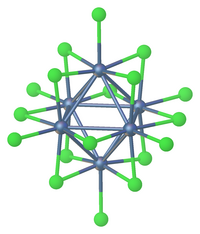Tantalum(III) chloride
| Names | |
|---|---|
| Other names
tantalum trichloride
| |
| Identifiers | |
3D model (JSmol)
|
|
| ChemSpider | |
| ECHA InfoCard | 100.033.611 |
| EC Number |
|
PubChem CID
|
|
CompTox Dashboard (EPA)
|
|
| |
| |
| Properties | |
| Cl3Ta | |
| Molar mass | 287.30 g·mol−1 |
| Appearance | black-green |
| Melting point | 440 °C (824 °F; 713 K) decomposes[1] |
| yes | |
| Related compounds | |
Other anions
|
|
Other cations
|
Niobium(III) chloride |
Related compounds
|
Tantalum(V) chloride |
Except where otherwise noted, data are given for materials in their standard state (at 25 °C [77 °F], 100 kPa). | |
| Infobox references | |
Tantalum(III) chloride or tantalum trichloride is non-stoichiometric with a range of composition from TaCl2.9 to TaCl3.1[2] Anionic and neutral clusters containing Ta(III) chloride include [Ta6Cl18]4− and [Ta6Cl14](H2O)4.[3]

Formation[]
Tantalum(III) chloride is formed by reducing tantalum(V) chloride with tantalum metal. this is done by heating tantalum(III) chloride to 305°C, passing the vapour over tantalum foil at 600°, and condensing the trichloride at 365°C. If the condensing region is kept at too high a temperature, then TaCl2.5 deposits instead.[5]
The trichloride can also be prepared by thermal decomposition of TaCl4, with removal of volatile TaCl5. TaCl5 can be vapourised leaving behind TaCl3.[6]
Reduction of a toluene solution of TaCl5 with 1,4-disilyl-cyclohexadiene in the presence of ethylene produces a complex of TaCl3:[7]
- TaCl5 + C6H6(SiMe3)2 → "TaCl3" + C6H6 + 2 Me3SiCl
Properties[]
Above 500 °C, TaCl3 disproportionates further releasing TaCl5.[6] TaCl3 is insoluble in room temperature water, or dilute acid, but dissolves in boiling water. A blue-green solution is formed.[6]
Complexes[]
Tantalum(III) chloride can form complexes with some ligands as a monomer or dimer.
Complexes include Ta(=C-CMe3)(PMe3)2Cl3, [TaCl3(P(CH2C6H5)3THF]2μ-N2 and [TaCl3THF2]2μ-N2 (dinitrogen complexes).[8]
As a dimer, complexes include Ta2Cl6(SC4H8)3 (SC4H8=tetrahydrothiophene). Ta2Cl6(SMe2)3, Ta2Cl6(thiane)3 and Ta2Cl6(thiolane)3 have a double bond between the two tantalum atoms, and two bridging chlorides, and a bridging ligand.[9]
References[]
- ^ Haynes, William M. (2016). CRC Handbook of Chemistry and Physics (97 ed.). CRC Press. p. 4–97. ISBN 978-1-4987-5429-3.
- ^ Cotton, F Albert; Wilkinson, Geoffrey (1966). Advanced Inorganic Chemistry A Comprehensive Text. John Wiley. p. 927.
- ^ Duraisamy, Thirumalai; Hay, Daniel N. T.; Messerle, Louis (2014). "Octahedral Hexatantalum Halide Clusters". Inorganic Syntheses: Volume 36. Inorganic Syntheses. 36. pp. 1–8. doi:10.1002/9781118744994.ch1. ISBN 9781118744994.
- ^ Thaxton, C. B.; Jacobson, R. A. (1971). "The Crystal Structure of H2(Ta6Cl18)(H2O)6". Inorganic Chemistry. 10: 1460–1463. doi:10.1021/ic50101a029.CS1 maint: uses authors parameter (link)
- ^ Gutmann, Viktor (2012). Halogen Chemistry. Elsevier. p. 158. ISBN 978-0-323-14847-4.
- ^ a b c Remy, Heinrich (1963). Treatise on Inorganic Chemistry: Sub-groups of the periodic table and general topics. Elsevier Publishing Company. p. 115.
- ^ Arteaga-Müller, Rocío; Tsurugi, Hayato; Saito, Teruhiko; Yanagawa, Masao; Oda, Seiji; Mashima, Kazushi (2009). "New Tantalum Ligand-Free Catalyst System for Highly Selective Trimerization of Ethylene Affording 1-Hexene: New Evidence of a Metallacycle Mechanism". Journal of the American Chemical Society. 131 (15): 5370–5371. doi:10.1021/ja8100837. PMID 20560633.
- ^ Churchill, Melvyn Rowen.; Wasserman, Harvey J. (January 1982). "The Ta(.mu.-N2)Ta system. 2. Crystal structure of [TaCl3(P(bz)3)(THF)]2(.mu.-N2)..apprx.0.7CH2Cl2. A binuclear di-imido complex of octahedral tantalum (V)". Inorganic Chemistry. 21 (1): 218–222. doi:10.1021/ic00131a040.
- ^ Matsuura, Masatoshi; Fujihara, Takashi; Kakeya, Masaki; Sugaya, Tomoaki; Nagasawa, Akira (November 2013). "Dinuclear niobium(III) and tantalum(III) complexes with thioether and selenoether ligands [{MIIIX2(L)}2(μ-X)2(μ-L)] (M = Nb, Ta; X = Cl, Br; L = R2S, R2Se): Syntheses, structures, and the optimal conditions and the mechanism of the catalysis for regioselective cyclotrimerization of alkynes". Journal of Organometallic Chemistry. 745–746: 288–298. doi:10.1016/j.jorganchem.2013.07.035.
- Tantalum compounds
- Chlorides
- Non-stoichiometric compounds